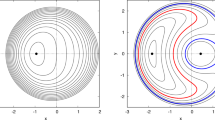Abstract
The asteroid tethered swingby maneuver (ATSM) is analyzed in this paper. The maneuver implies turn of the spacecraft velocity by means of a tether anchored to an asteroid. Mission to Haumea dwarf planet is considered. The following spacecraft transfer trajectories with launch in 2025 and 2027 are analyzed in the paper: Earth–Jupiter–Haumea and Earth–ATSM–Jupiter–Haumea. Only asteroids bigger than 40 km in diameter were considered in order to make hitting the asteroid by the tether anchor easier. Many Main Belt asteroids lowering total \(\Delta V\) of the transfers were found. A few of them giving the maximum effect of ATSM were selected and the transfers using them are analyzed in details. It is shown that the ATSM using these asteroids would lower substantially the total \(\Delta V\) or shorten significantly the time of flight. Technical problems of the ATSM implementation, such as possibly big mass of the tether and anchor, difficulty of hitting the asteroid and anchoring the tether securely etc., are considered. These problems would not allow to implement the ATSM at present time, but hopefully will be solved in near future.













Similar content being viewed by others
Notes
This summation is not quite correct because the launch is performed by the kick stage and other impulses are produced by the onboard engine with different characteristics. Although the total \(\Delta V\) is the only parameter allowing estimate feasibility of the mission until the kick stage and onboard engine characteristics are unknown.
Note that the spacecraft motion relatively to the asteroid is close to the rectilinear uniform motion for a relatively long time. This is why we can assume that \(v\) is constant during all the operations near asteroid.
References
Broucke, R.A.: The celestial mechanics of gravity assist. AIAA Paper 88-4220 (1988)
Casalino, L., Colasurdo, G., Pasttrone, D.: Optimal low-thrust escape trajectories using gravity assist. J. Guid. Control Dyn. 22(5), 637–642 (1999)
D’Amario, L.A., Byrnes, D.V., Stanford, R.H.: Interplanetary trajectory optimization with application to Galileo. J. Guid. Control Dyn. 5(5), 465–471 (1982)
Dowling, R.L., Kosmann, W.J., Minovitch, M.A., Ridenoure, R.W.: Gravity propulsion research at UCLA and JPL, 1962–1964. In: 41st Con. of the IAF, Dresden, GDR, 6–12 Oct. 1991
Grard, R.: Mercury: the Messenger and BepiColombo missions a concerted approach to the exploration of the planet. Adv. Space Res. 38, 563 (2006). https://doi.org/10.1016/j.asr.2006.06.015
Helton, A.F., Strange, N.J., Longuski, J.M.: Automated design of the Europa orbiter tour. J. Spacecr. Rockets 39, 17–22 (2002)
Kohlhase, C.E., Penzo, P.A.: Voyager mission description. Space Sci. Rev. 21(2), 77–101 (1977)
Lanoix, E.L.M.: Tether sling shot assists: a novel approach to travelling in the solar system. In: Proceedings of the 9th Canadian Aeronautics and Space Institute Conference on Astronautics, Ottawa, Canada, pp. 62–71 (1996)
Lanoix, E.L.M., Misra, A.K.: Near-Earth asteroid missions using tether sling shot assist. J. Spacecr. Rockets 37(4), 475–480 (2000)
Longuski, J.M., Williams, S.N.: The last grand tour opportunity to Pluto. J. Astronaut. Sci. 39, 359–365 (1991)
McConaghy, T.T., Debban, T.J., Petropulos, A.E., Longunski, J.M.: Design and optimization of low-thrust gravity trajectories with gravity assist. J. Spacecr. Rockets 40(3), 380–387 (2003)
McNutt, R.L. Jr., Solomon, S.C., Grard, R., Novara, M., Mukai, T.: An international program for Mercury exploration: synergy of Messenger and BepiColombo. Adv. Space Res. 33, 2126 (2004). https://doi.org/10.1016/S0273-1177(03)00439-3
McNutt, R.L. Jr., Solomon, S.C., Gold, R.E., Leary, J.C.: The Messenger mission to Mercury: development history and early mission status. Adv. Space Res. 38, 564 (2006). https://doi.org/10.1016/j.asr.2005.05.044
Okutsu, M., Yam, C.H., Longuski, J.M.: Low-thrust trajectories to Jupiter via gravity assists from Venus, Earth and Mars. AIAA Paper 2006-6745 (2006)
Penzo, P.A., Mayer, H.L.: Tethers and asteroids for artificial gravity assist in the solar system. J. Spacecr. Rockets 23(1), 79–82 (1986)
Petropoulos, A.E., Longuski, J.M., Vinh, N.X.: Shape-based analytic representations of low-thrust trajectories for gravity-assist applications. American Astronautical Society, AAS Paper 99-337 (Aug. 1999)
Prado, A.F.B.A.: Using tethered gravity assisted maneuvers for planetary capture. J. Guid. Control Dyn. 38, 1852–1856 (2015)
Prado, A.F.B.A.: Tethered gravity assisted maneuvers in close approach asteroids to accelerate a spacecraft. Adv. Astronaut. Sci. 156, 3853–3872 (2016)
Prado, A.F.B.A., Gomes, V.M., Chanut, T.G.G.: Building an “escape portal” with tethers fixed in asteroids. J. Astronaut. Sci. 65(3), 355–375 (2018)
Puig-Suari, J., Longuski, J.M., Tragesser, S.G.: A tether sling for lunar and interplanetary exploration. Acta Astronaut. 36(6), 291–295 (1995)
Sanchez, D.M., Prado, A.F.B.A., Sukhanov, A.A., Yokoyama, T.: Optimal transfer trajectories to the Haumea system. In: 13th International Conference on Space Operations 2014, Pasadena, vol. 1. American Institute of Aeronautics and Astronautics, Reston (2014)
Strange, N.J., Longunski, J.M.: Graphical method for gravity-assist trajectory design. J. Spacecr. Rockets 39(1), 9–16 (2002)
Sukhanov, A.A.: Universal solution of Lambert’s problem. Cosm. Res. 26, 415–423 (1988)
Sukhanov, A.: Close approach to Sun using gravity assists of the inner planets. Acta Astronaut. 45, 177–185 (1999)
Thompson, W.B., Stern, M.O.: A skyhook from Phobos to Mars. In: Proceedings of the 4th International Conference on Tethers in Space, pp. 1737–1745. NASA, Washington (1995)
Acknowledgements
The authors thank the grants # 473387/2012-3, 473164/2013-2, 406841/2016-0 and 301338/2016-7 from the National Council for Scientific and Technological Development (CNPq); and grants # 2015/19880-6, 2016/24561-0 and 2016/14665-2 from São Paulo Research Foundation (FAPESP).
Author information
Authors and Affiliations
Corresponding author
Rights and permissions
About this article
Cite this article
Sukhanov, A., Prado, A.F.B.d.A. Use of the tethered swingby maneuver to reach the Haumea dwarf planet. Astrophys Space Sci 364, 2 (2019). https://doi.org/10.1007/s10509-018-3488-6
Received:
Accepted:
Published:
DOI: https://doi.org/10.1007/s10509-018-3488-6




